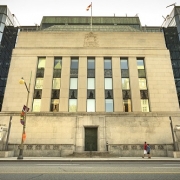The Bank of Canada (BoC) has made another unscheduled rate cut, slashing its Overnight Lending Rate by 50 basis points from 0.75% to 0.25% – the lowest it has been since April 2009 – as further response to the COVID-19 pandemic and its impact on the Canadian economy. It is the third rate cut the BoC has made in March, slicing a total of a percentage point from where it stood in February.
“The spread of COVID-19 is having serious consequences for Canadians and for the economy, as is the abrupt decline in world oil prices,” stated the BoC in a release. “The pandemic-driven contraction has prompted decisive fiscal policy action in Canada to support individuals and businesses and to minimize any permanent damage to the structure of the economy.”
A “Complimentary” Approach to Support Canadians
The BoC’s move today is meant to support the fiscal efforts of the federal government, which has been rolling out assistance programs for Canadians whose incomes have been impacted by COVID-19, either due to the need to self-isolate, job loss, or the need to stay home from work to provide childcare. By cutting interest rates, the BoC keeps the cost of borrowing low both for lenders and consumers, which helps keep the market liquid and spending moving during times of economic upheaval.
“The intent of our decision today is to support the financial system in its central role of providing credit in the economy, and to lay the foundation for the economy’s return to normalcy,” the BoC stated.
The BoC has also announced it will roll out two programs to keep funding flowing for small businesses and support overall economic recovery, by buying back Government of Canada bonds, securities, and other financial instruments.
Could More Interest Rate Cuts Be on the Way?
It appears the BoC may not be finished with its downward trajectory, strongly indicating that more cuts may come as the situation evolves. It will continue to closely monitor the economy in co-ordination with the other G7 banks. “Governing Council stands ready to take further action as required to support the Canadian economy and financial system and to keep inflation on target,” states its release. The move to cut has been made by central banks globally in efforts to shore up economies amid COVID-19, including the U.S. Federal Reserve, which slashed its own rate to near zero on March 16.
The BoC also stated it will release its full economic update in its next scheduled rate announcement, on April 15.
What Does This Mean for Mortgage Borrowers?
Think of the BoC’s Overnight Lending Rate as a benchmark – it is a basis used by consumer lenders, such as TD, RBC, etc. when setting their Prime Rate-priced products. This means whatever the BoC does will have a direct impact on variable-rate products, such as variable mortgages and lines of credit.
As a result, those with variable-rate mortgages will see either their monthly payments drop in tandem, or more of their payment going toward their principal debt and less towards interest.
Those currently locked into a fixed-rate mortgage term will not see their payments or interest rate affected by today’s announcement, though those getting a brand-new fixed-rate mortgage, or coming up to renewal or refinance, will likely have access to lower rates than compared to a month ago, as lenders take their cues for fixed-rate pricing from the bond market.
That’s because, in times of economic uncertainty, investor demand for “safe haven”investments such as government bonds, rises. That in turn causes bond yields to drop – they have an inverse relationship with investor demand, as the maturity payoff tends to be lower for low-risk investments. Investors are particularly drawn to bonds when the BoC’s rate is low, as it means whatever investments they purchase now will be at a discount, and unlikely to have their values lowered in the near future by a rate increase.
As of today, the Government of Canada five-year bond yield sits at 0.76% – a multi-year low.









 Maziar Moini, Broker of Record - Home Leader Realty Inc.
300 Richmond St. W., #300, Toronto, ON M5V-1X2
Maziar Moini, Broker of Record - Home Leader Realty Inc.
300 Richmond St. W., #300, Toronto, ON M5V-1X2



